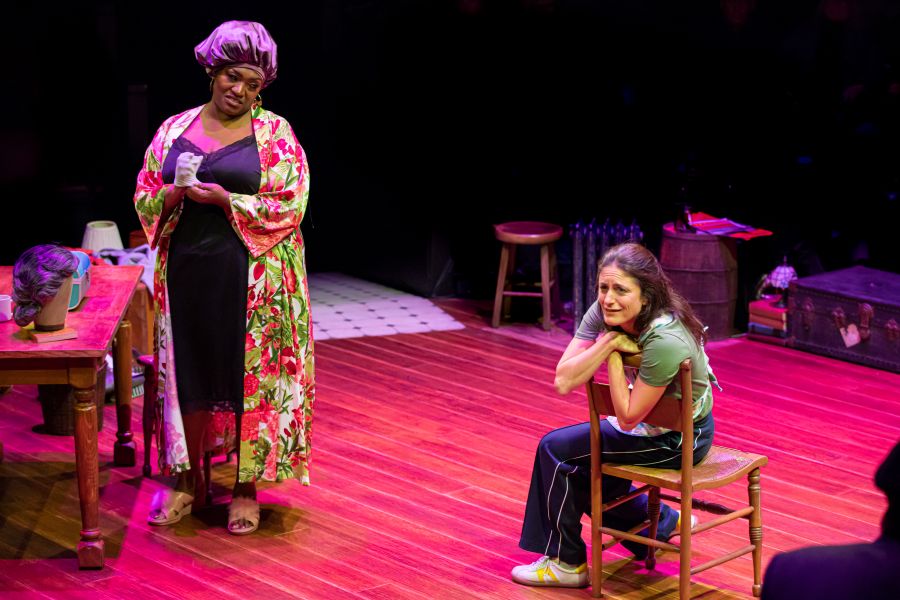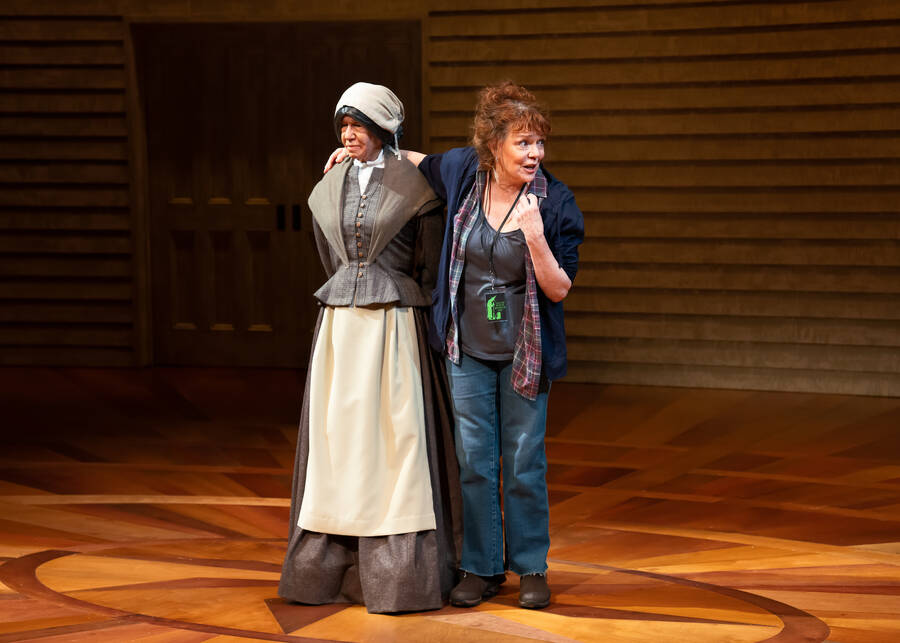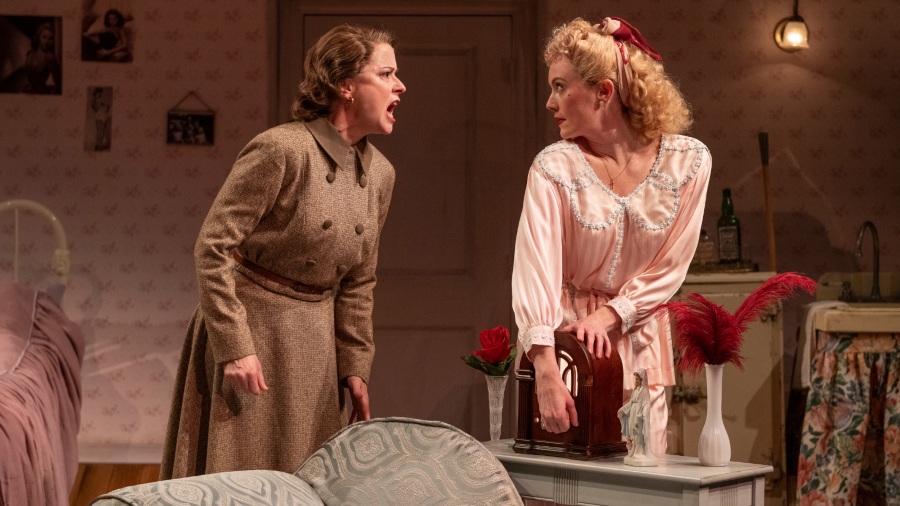They are among the most famous words spoken by a woman in a canonical American play: “Attention must be paid.” It’s Linda Loman, of course, in Arthur Miller’s Death of a Salesman, admonishing her oldest son, Biff, to show his late father some respect. “He’s not to be allowed to fall into his grave like an old dog,” Linda insists. “Attention, attention must finally be paid to such a person.”
“Such a person” was understood in a number of ways when Salesman opened on Broadway in 1949. It could refer to an abstract “capitalized Human Being without being anyone, a suffering animal who commands helpless pity,” as Mary McCarthy put it, or a heroic striver playing by the rules yet beaten down by a punishing capitalist system, the hero of what Miller called a tragedy of “the common man.”
One thing “such a person” absolutely didn’t mean then: a woman. On the contrary, for Miller, in order for a protagonist to confront a moral test within the social sphere, he had to be male. The main women in Salesman—and in Miller’s other most studied and produced play, The Crucible—are a dutiful, chore-laden wife (Linda Loman; Elizabeth Proctor) and a sexual temptress (the otherwise unnamed “Woman” with whom Willy has an affair; Abigail Williams). The issue isn’t that these characters are weak or unbelievable in their contexts. The problem is structural: The erotic lure of the Woman and of Abigail is what catalyzes the hero’s self-sacrificing downfall in both plays.
Over the decades feminist critics and scholars too numerous to name have grappled productively with Miller’s reliance on the old madonna/whore dichotomy and with his narrow ideas of masculinity. More recently, though, it is playwrights who have been taking on the gender issues that Miller seemed oblivious to, as the Broadway marquee currently proclaiming John Proctor is the Villain makes plain. The play with that table-turning title, by Kimberly Belflower, is one of at least nine American works for the stage that fire feminist rejoinders to Miller. They too demand that attention must be paid, but reorient what—and to whom—it is due.

Different as these plays are from each other in form, tone, focus, and perspective, they all signal urgently through the sexist smog that has risen off these American classics in the nearly three-quarters of a century since they were written. Five of these new plays riff on The Crucible (1953) and three on Salesman (1949), and one takes inspiration from All My Sons (1946). Some frame the Miller work under scrutiny as a play-not-quite-within-the-play (Belflower’s play; Katie Forgette’s Mrs. Loman is Leaving; Sheri Wilner’s Kingdom City). Others take a sophisticated fan-fic tack by setting Miller’s characters in plots that come before, or after (Liz Duffy Adams’s Witch Hunt; Eleanor Burgess’s Wife of a Salesman; Barbara Cassidy’s Mrs. Loman; Talene Monahon’s The Good John Proctor).
Some whirl into more fanciful forms that abstractly incorporate aspects of both approaches (Julia May Jonas’s A Woman Among Women; Sarah Ruhl’s Becky Nurse of Salem). Miller has become especially ripe for such treatment in recent years for reasons that, like those that impel many of his protagonists, have to do with his reputation and with the ineluctable social forces that shape it. For one, his standing as a Classic American Playwright has been solidified for two generations. The critics who disparaged his plays as having “middlebrow” pretensions in the serious magazines of 1950s and ’60s—Eric Bentley, Robert Brustein, and Richard Gilman, among others—are no longer with us (neither, for that matter, are the theatre pages in the magazines that employed them). More significantly, the high/low culture distinctions they labored to uphold—with pretentious “midcult” art being the worst of all for trying to be at once hugely popular and artistically momentous—have evaporated into the postmodern ether. Nowadays, no one questions Miller’s place in America’s playwriting pantheon, even if we object to his disregard for women as potential tragic heroes. That Miller, more than Eugene O’Neill or Tennessee Williams, has also been widely regarded as a preeminent moral conscience among American dramatists, has been a further goad to the creative scrutiny of feminist playwrights.

Their countervailing plays emerged in the wake of political developments that not only spurred them on, but that surface overtly in their work. Take Ruhl’s mordant comedy, Becky Nurse of Salem, for instance. Set in 2016 in the infamous Massachusetts town, the play has as its title character the foul-mouthed, opioid-popping descendant of Rebecca Nurse, a midwife hanged for alleged witchcraft some 325 years earlier. Becky is struggling to make ends meet as she raises her teenage granddaughter. Frequently, she has to ask someone to turn down a TV blaring coverage of a Trump rally (“Lock her up! Lock her up!”). In a scene when Becky is arrested for trying, without a license, to correct the historical record by offering “The Real Tour of Salem,” the scene shifts (“bizarrely,” say the stage directions) to 1692, and Becky becomes Rebecca. A live crowd chants the same menacing words, denouncing her as a witch. Time periodically collapses and springs back in Ruhl’s play: Language, clothing, and customs change, but misogyny holds constant through the centuries.
These plays reflect, too, demands made by both the Black Lives Matter and #MeToo movements that Americans face up to shameful realities of our histories and to inequities that persist. Not that anyone is trying to topple Miller like a Confederate statue. Rather, the new plays resemble the contextualizing and additive materials that historians recommend placing around such monuments.
Like Becky, Adams’s, Monahon’s, and Belflower’s plays emend a factual inaccuracy in The Crucible, noting that Abigail was all of 11 years old at the time of the witch trials, and Proctor, 60—not, respectively, 17 and 30-something, as Miller deliberately rendered them to make Abigail the seductress of a male paragon of integrity. (Stacy Schiff’s meticulous 2015 account of the Salem witch trials in her book, The Witches: Salem, 1692, set the record straight.) In different ways, these writers call into question The Crucible’s inciting incident, Proctor’s “affair” with Abigail, and skewer the punishing patriarchal worldview of Puritan New England—and of Arthur Miller—that discredits, and often silences, women’s voices.
In her thriller Witch Hunt Or, A Discourse on the Wonders of the Invisible World, Adams picks up the story after the witch trials. Abigail, having fled Salem, returns to the region a decade later, seeking to understand why the town’s “high and powerful men” urged the girls on. “They had never listened to ones so low as us in their lives,” she says. “Now they killed people on our word.”
Setting The Good John Proctor in 1691, the year before Miller’s play is set, Monahon brings us into the dreams, drudgery, and degradations of Salem’s pubescent girls in a series of short, mystery-tinged, Caryl Churchill-like scenes. Abigail is 11 (and nonbinary), and her cousin, Betty, only 9. Using 21st-century language in a 17th-century world, Monahon connects the mistrust and exploitation of Salem’s girls to the suppression #MeToo sought to shake off.
The girls in John Proctor Is the Villain are high school students in a small town studying The Crucible in their English class and finding disturbing parallels between the old text and their own lives—rife, as they are, with creepy adult men and the adolescent upheaval of sexual feelings. Says one:
The thing this play is talking about is that pretty much all these girls had been like assaulted at some point. I mean like sexually. I read this book that says most of these girls probably had like PTSD which explains the like crazy physical fits that people thought were happening because of witchcraft but anyway so yeah like the assault stuff was everywhere. Their dads, older men in the town, stable boys, whoever…
The reading-against-the-grain insights these students glean from The Crucible help bring local real-life abuses to light. The play culminates with the girls dancing in an ecstatic frenzy, reclaiming as feminist bonding and expression what had earlier been condemned as witchcraft.

Building dramatic action around studying or staging a Miller play provides several of the feminist playwrights opportunities for direct, even bald, commentary on the original. Forgette makes great use of this ploy in her hilarious backstage comedy, Mrs. Loman is Leaving, in which two aging actors are making their comebacks in Salesman. But there are offstage bumps: The man playing Willy is hallucinating as wildly as his character, while Joanne, the woman playing Linda, is falling apart after she learns, via text, shortly before curtain, that her husband is leaving her. Her grief and fury over her personal crisis commingle with Linda’s and color her challenge to the director’s encomiums about Willy.
I have to interrupt before you can spin out some half-baked explanation of why it’s okay for this bloviating mediocre man to treat a woman who has devoted her life to his every need. Why is she mending her stockings?! He gives stockings to his girlfriend! Where are Linda’s? WHERE ARE LINDA’S STOCKINGS!!!???
When the director retorts that Linda “represents the expectations and limitations of her gender for the time period. Women were helpmates. They supported their husbands,” Joanne replies, “That doesn’t mean that she didn’t have a personal dream of her own. What was Linda’s dream before she gave it up?”
In her sequel to Salesman, Cassidy takes up such questions, extending the psychological depth Miller grants his male characters to Linda. Mrs. Loman begins after Willy’s funeral, as Linda enrolls in college, develops a friendship with another woman who mysteriously knew Willy, and challenges her son, Happy, over his appalling misogyny. In a prequel, Wife of a Salesman, Burgess uses both strategies: She imagines Linda confronting the Woman, ahead of the moment in Miller’s plot when Biff learns of his father’s affair, potentially erasing its inciting incident. Later Burgess disrupts the action, revealing the whole thing as a play-within-the-play; the two actors performing “Wife” and “Mistress” comment on their roles and their own somewhat parallel lives.
Rather than parallel, Jonas’s characters in A Woman Among Women run aslant of Miller’s in All My Sons; of this new crop of Miller riffs, hers offers the most oblique response to the play that inspired it, as she explores his dramatic vision but swaps out his lenses for her own. All My Sons centers on a “man among men,” as Miller called Joe Keller, a respected businessman who secretly holds onto an incriminating lie to retain his stature. While reversing most of the characters’ genders and moving the action from a small Ohio town to famously multi-culti, queer-friendly Northampton, Massachusetts, Jonas borrows Miller’s backyard setting and other key elements: a central family with two grown children, one of whom is absent; a close-knit community of neighbors; high-stakes questions of moral responsibility; Aristotelian principles of tragedy.
In a note in the script, Jonas says she set out to discover what a “woman among women” might mean. Her answer not only emerges in the shape of an almost casual, fourth-wall-breaking style that features some quirky little songs. It also gives its hero, who runs a “wellness center for women,” a transgression less blatantly self-serving than Joe Keller’s—and, forsaking Miller’s certainty, a denouement that leaves everything in doubt.

It’s impossible to know what Miller himself might have made of these dramaturgical clapbacks. Forty years ago, when the Wooster Group incorporated a large chunk of The Crucible into L.S.D. (…Just the High Points), the troupe’s mash-up of a high-speed recitation of Miller’s text with passages from Timothy Leary’s treatise on the hallucinogen, he objected, and the show was eventually shut down. “Maybe at some point in the future,’’ Miller told The New York Times then, “the play will become a kind of public classic. But I’m still around and I should have a say about how the play is done as long as I am.”
The plays are public classics now (some intellectual property restrictions notwithstanding), available to a robust playwriting tradition of theatrically talking back to canonical plays in a feminist register: Elaine Feinstein’s Lear’s Daughters, Zinnie Harris’s Macbeth (An Undoing), and Paula Vogel’s Desdemona: A Play about a Handkerchief all transpose Shakespeare in this way. Such works shrewdly craft fresh stories from revered old ones to critically engage the past, the present, and the ways we construct the past in—and for—the present.
One thing is certain. All nine of the feminist playwrights wrestling with their towering predecessor share one of Miller’s steadfast principles: that theatre matters, that it is the ideal sphere for examining social pressures, their fractures, and the impact they have on ordinary lives.
The word “feminist” does not appear on any of the 600 pages of Miller’s autobiography, Timebends. Still, when he writes, “I could not imagine a theatre worth my time that did not want to change the world,” he offers these new plays a full endorsement.
Alisa Solomon (she/her), a professor at Columbia University’s Graduate School of Journalism, is a long-time theatre critic and general reporter for Village Voice, Jewish Currents, The Nation, and The New York Times, among other publications.
Support American Theatre: a just and thriving theatre ecology begins with information for all. Please join us in this mission by joining TCG, which entitles you to copies of our quarterly print magazine and helps support a long legacy of quality nonprofit arts journalism.
Related

Attention Must Be Paid to the Translator in ‘Salesman之死’
Yangtze Rep's new production looks behind the scenes, and under the layers, of Arthur Miller's Beijing staging of 'Death of a Salesman.'
In "Fall 2023"

The Rise and Fall of Arthur Miller
John Lahr's new biography recounts the story of a playwright who met his historical moment like few before or since, then struggled for a second act.
In "Book Reviews"
New Territory for ‘Salesman’
A review of ‘Salesman in Beijing’ by Arthur Miller, with photographs by Inge Morath, Viking Press, New York, N.Y. 254 pp, $16.95 cloth.
In "Book Reviews"





